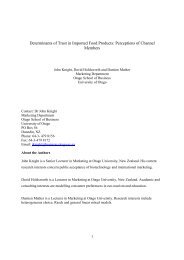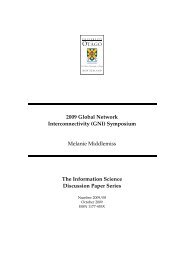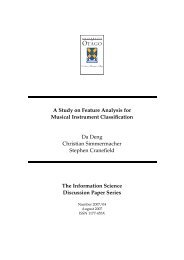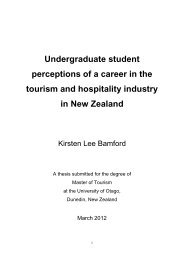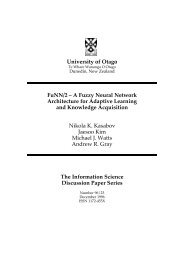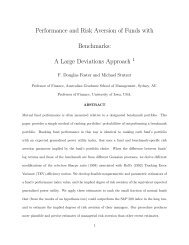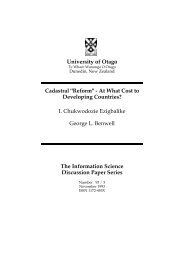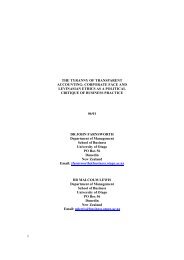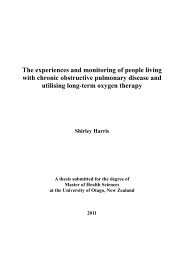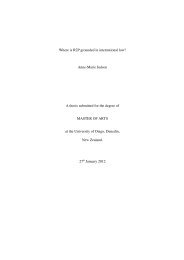Reframing perceptions of anthropomorphism in wildlife film and ...
Reframing perceptions of anthropomorphism in wildlife film and ...
Reframing perceptions of anthropomorphism in wildlife film and ...
You also want an ePaper? Increase the reach of your titles
YUMPU automatically turns print PDFs into web optimized ePapers that Google loves.
1.4) Rationale<br />
In <strong>wildlife</strong> <strong>film</strong> <strong>and</strong> documentary there has always been a tension between two<br />
objectives– the desire to deliver scientific <strong>in</strong>formation to an audience <strong>and</strong> the desire to<br />
enterta<strong>in</strong> an audience. The use <strong>of</strong> anthropomorphic techniques has frequently been<br />
criticised as an easy means <strong>of</strong> <strong>in</strong>creas<strong>in</strong>g pr<strong>of</strong>its <strong>and</strong> rat<strong>in</strong>gs through sentimentalism <strong>and</strong><br />
sensationalism (Mitman 1993, Bouse 1998, Mitman 1999, K<strong>in</strong>g 1996, Bouse 2000,<br />
Pierson 2005, Porter 2006). This is particularly apparent <strong>in</strong> the constant criticism <strong>of</strong><br />
‗rat<strong>in</strong>gs-driven‘ or ‗pie-slice‘ syndicated factual programm<strong>in</strong>g broadcast on cable<br />
television (Bouse 1998, Bouse 2000, Pierson 2005, Kilborn 2006). Popular animal<br />
programm<strong>in</strong>g like Meerkat Manor <strong>and</strong> Orangutan Isl<strong>and</strong> <strong>of</strong>ten centre around highly<br />
anthropomorphised constructs <strong>and</strong> are criticised as factual ‗enterta<strong>in</strong>ment‘ <strong>and</strong> for<br />
lack<strong>in</strong>g scientific or educational value.<br />
Very little research has looked beyond <strong>anthropomorphism</strong>s' supposed lack <strong>of</strong> ‗scientific<br />
value‘. This thesis seeks to reframe <strong>perceptions</strong> <strong>of</strong> <strong>anthropomorphism</strong> <strong>and</strong> <strong>in</strong>vestigate<br />
why <strong>and</strong> how we anthropomorphise animals on <strong>film</strong>. It seeks to underst<strong>and</strong><br />
<strong>anthropomorphism</strong>‘s potential to create connectivity between audiences <strong>and</strong> the animals<br />
on screen <strong>and</strong> its potential to change the public‘s environmental values.<br />
1.5) Outl<strong>in</strong>e<br />
The constructs <strong>of</strong> <strong>anthropomorphism</strong> with<strong>in</strong> nature documentary <strong>and</strong> its possible<br />
<strong>in</strong>fluences on environmental conservation will be discussed.<br />
I will argue that <strong>anthropomorphism</strong> is essential if humans are to underst<strong>and</strong> <strong>wildlife</strong> <strong>in</strong><br />
documentary <strong>and</strong> <strong>film</strong> – these representations becom<strong>in</strong>g an extension <strong>of</strong> our own social<br />
<strong>and</strong> cultural underst<strong>and</strong><strong>in</strong>gs. I also seek to exam<strong>in</strong>e this paradox, for while<br />
<strong>anthropomorphism</strong> can distance us from the realities <strong>of</strong> <strong>wildlife</strong> it appears it can also<br />
allow nature to become an <strong>in</strong>tegral part <strong>of</strong> our worldview. I will suggest that it is this<br />
anthropomorphically created empathy that may have <strong>in</strong>fluenced the growth <strong>and</strong> support<br />
<strong>of</strong> <strong>wildlife</strong> conservation.<br />
4




